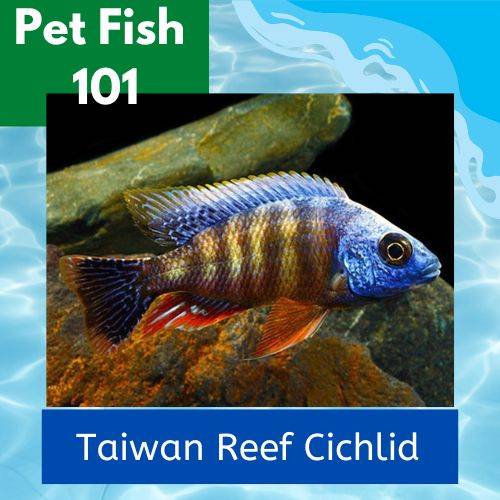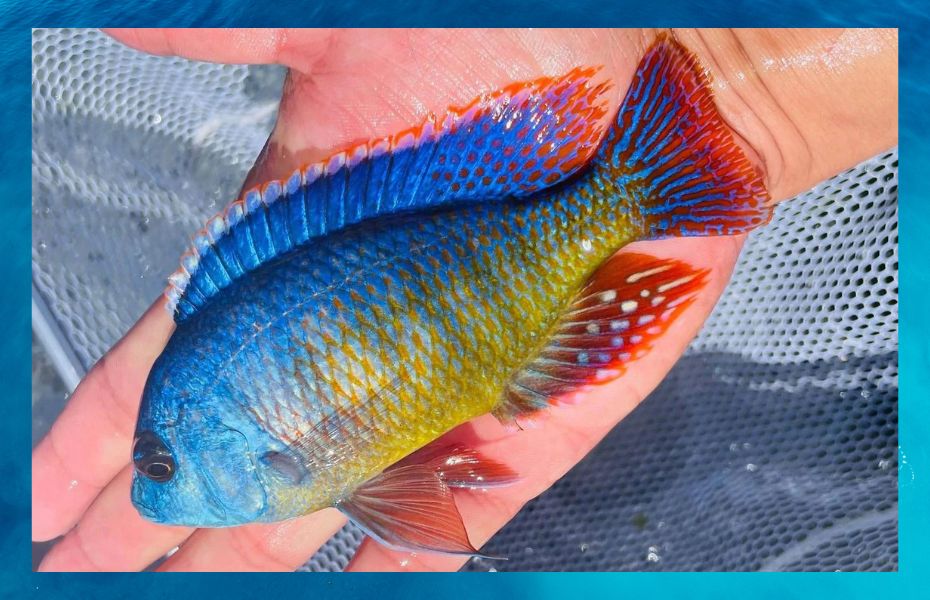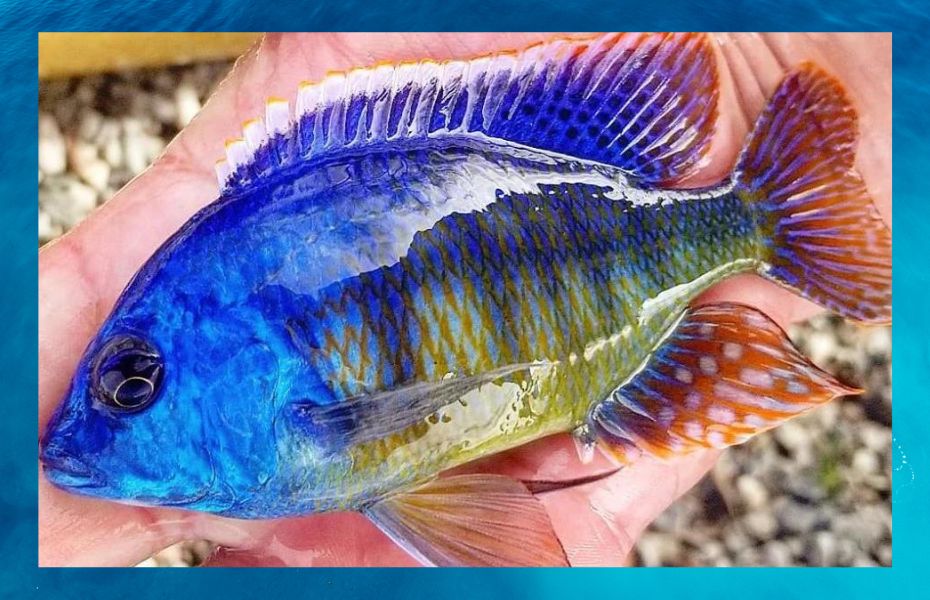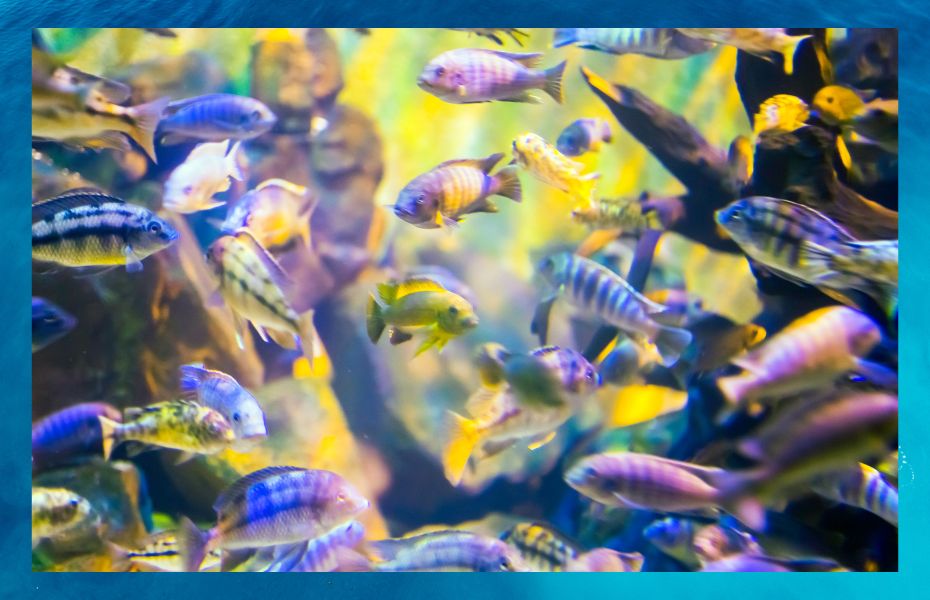I have used Amazon affiliate links on this page. As an Amazon Associate, I earn a commission from qualifying purchases at no added cost to you. Thank you!


The Taiwan Reef Cichlid is an iconic species of Haplochromis with a vibrant array of colors. They also grow to an average size of around 7 inches and are easy to distinguish from the other varieties of fish in an aquarium because of their unique coloring.
This fish is an unidentified species from Lake Malawi that is also known as Protomelas sp. Steveni Taiwan and Taiwan Reef steveni. This colorful and energetic fish is called the Taiwan Reef, or more precisely, Taiwanee Reef, where it was initially discovered (There’s no connection between the country Taiwan or any reef related to it with this cichlid). In the local language, “Taiwanee” refers to a “lost kid.”
This cichlid is praised for having stunning colors that pop. The Taiwanee Reef has a broader and shorter body than other Haps, which gives it a more cichlid-like appearance despite the fact that it is a Hap. Typically, the dorsal fin and top of their heads are white, while their bodies are typically red, blue, and yellow. Red covers the anal and pelvic fins. They may be distinguished from other species by the white-blue blaze on their heads.
Taiwan Reef Cichlids are slow starters, but when they do eventually grow up, they will be one of the main attractions of your aquarium. It is best to keep them with less aggressive Haps or Peacocks because these fish can’t hold their own against Taiwan Reef Cichlids.
Table of Contents
Quick Info on Taiwan Reef Cichlid

| Common Names | Steveni Taiwan, Taiwan Reef, Taiwan Reef Hap, Chimoto Reds |
| Scientific Name | Protomelas sp. Steveni Taiwan |
| Other names of Taiwan Reef Cichlids | Taiwan Reef, Steveni Taiwan, Chimoto Reds |
| Maximum size they reach | 7 inches |
| Minimum tank size required | 75 gallons |
| Water type | Hard |
| Ideal Temperature of the water | 78F to 82F |
| pH of the Water | 7.8 to 8.6 |
| KH: | 4 to 8 KH |
Appearance
Male fish tend to have brighter colors than females. Their bodies are predominantly yellow while they have a vibrant blue color across their heads, their backs, and down to their tails. The Taiwanese reef cichlid also has unique patterned spots on its body as well.
On the other hand, these fish have a brighter orange on their sides. They start with some blue near the back fin before transitioning into an intense red when they reach the tail fin; and though it may take them awhile to do so, many males don’t come out in their true colors until they’re over two years old and ready to spawn.
The female Taiwanese Reef Cichlid is silver in color. They have 6 vertical stripes on their bodies and 2 horizontal stripes that seem to form the letter H when you look at them.
Scientific Taxonomy and Native Habitat
Known as Protomelas sp. Steveni Taiwan and Taiwan Reef steveni, this brightly-colored cichlid species is native to Lake Malawi; when discovered in Taiwanee Reef, it was given the name because of its beauty and how reflective the color of its scales is in light. Interestingly enough, this fish is often found in different locations around Lake Malawi, among them including Mbamba Bay near Ngkuyo Island and Higga Reef near Dar es Salaam.
They are typically seen in shallower water in loose groups of less than 25 people in Lake Malawi.
These sexually dimorphic and maternal mouthbrooders are members of the Protomelas genus. This group of fish includes 16 different species
Did you know that there are close relatives to the Taiwanee Reef Cichlids that are really popular in the hobby? Check Below:
Protomelas taeniolatus (Red Empress Cichlid)
Protomelas dejunctus ( The Fire Blue Ndiwe cichlid)
Protomelas fenestratus (Fenestratus hap)
Protomelas insignis (one-and-a-half-stripe hap)
Life Span
The typical lifetime of a Taiwan reef cichlid in captivity is five years. With the right care, these fish may survive for seven to ten years.
Taiwanee Reef Cichlid Size

Taiwan reef cichlids in their natural habitat can grow up to 7 inches long, though they are usually a little shorter when kept in an aquarium. Males tend to get about 6–7 inches. Like other Malawi cichlids, the females are even smaller, hence, they grow up to 4.5–5 inches.
Remember that these are not fast-growing fish. In general, it takes about two years for them to reach their full size. So beware when giving extra foods to grow them quicker, because it generally does not work and leads to poor quality. Poor water quality leads to many different problems and can be lethal to the fish. Moreover, much like every other species of fish in the world, the growth rate of these fish mostly depends on how well you take care of them, including the adequate food and space to swim that you provide. It is possible for these beautiful creatures to turn out much smaller than expected if treated badly, which would be a real shame!
Taiwan Reef Cichlid Care & Maintenance of the Tank
Caring for Taiwan reef cichlids doesn’t require much work at all because they’re quite easy to take care of. You just need to make sure the temperature stays consistent and check if there are any changes to the pH levels.
You need to use a thermometer and make sure the temperature stays at an appropriate level. Also, make sure the pH is at an appropriate level as well- this can be done using a pH testing kit.
Water changes should be conducted moderately if your tank only contains Taiwan reef cichlids, but if there are other fish in the tank, especially ones that produce a lot of waste, change the water more often.
In addition, the tank’s filtration system needs to be set up such that the water flow is turbulent, similar to Lake Malawi. Always work to maintain the conditions as consistently as you can so that your fish can adapt rapidly.
Ideal Water Parameters
Choose a range between 78 and 82 degrees Fahrenheit so that the water’s temperature will resemble Lake Malawi. Maintain a pH of 7.8 to 8.6 to keep the water on the alkaline side.
Adding water additives like Malawi/Victoria Buffer and Cichlid Lake Salt is recommended. These additions will aid in creating the most ideal aquatic environment for African cichlids especially those coming from lake Malawi.
Minimum Tank Size for Taiwan Reef Cichlid
A tank size of at least 75 gallons (48 x 18 x 21) is recommended if you want to house a small number of Taiwan reef cichlids. However, larger tanks are always recommended over smaller tanks. Larger tanks provide more space for the school of fish to swim as they would in their natural habitat. Therefore, bigger tanks can increase the lifespan of these fish and keep them healthy and less stressed. Moreover, when you have a larger tank, it enables you to keep similar cichlid fish and suitable tankmates with them, which can be beneficial in many ways, including increasing the attractiveness of the tank.
Diet
In the wild, algae make up the majority of their diet, so it is advisable to give them food that they enjoy eating. They quickly take food that is heavy in vegetable matter and are herbivores. Feed them high-quality flakes and commercial cichlid pellets. Their main dietary source needs to be spirulina algae. Keep in mind that they have a robust diet and are voracious, much like other Protomelas species. In order to prevent eventual stomach issues, do not overfeed them.
Temperament: Aggression and Tank Mates

As a rule of thumb, this fish will do well in a tank with less aggressive haps or peacocks.
They are often found in shallower water in loose groups of less than 25 individuals in Lake Malawi.
To limit their hostility, you may alternatively keep them in a pack of 8–12 animals in a tank designated for just that species. However, they get along nicely with other peacocks and haps of like size and disposition. Taiwan Reef Cichlids are a little awkward but only somewhat aggressive. Additionally, you may keep them in the same tank as timidly aggressive mbuna. However, only a tank big enough for each fish to have its own region is advised. Select a larger, more resilient species of catfish from Lake Tanganyika, such as Synodontis multipunctatus, if you absolutely want to include them.
Breeding Taiwanee Reef
As mouthbrooders, Taiwan Reef Cichlids are a sexually dimorphic species of fish in which the males grow to be bigger than the females. While the females will continue to have a silvery gray tint, the males will also exhibit stronger colorations.
Protomelas sp. Steveni Taiwan, like the majority of the other African cichlids in Lake Malawi, mouth breeds. They mature at a height of around 2.5 to 3 inches.
To distribute the male’s attention among the females, it is advised to set up a separate breeding tank with one male and numerous females. Make sure there are enough tunnels and hiding places for the females to take refuge in. When it’s time to spawn, the male will grow more hostile and intensely colored. Hence, it will try to entice her inside his cave so he can fertilize her eggs there. The female will then take them into her mouth and carry them there for the next 21 to 28 days of incubation. Although it is very little, the fry is developing quickly. To encourage their growth, you can give them freshly born brine shrimp to eat. In 4-5 weeks, they can grow to around half an inch.
Diseases And How To Prevent Them
There is a considerable likelihood that aquarium fish will become unwell at some time since there are many different ways in which they might be exposed to diseases. Maintaining a high level of water quality in the aquarium is the best course of action.
However, taiwanese reef cichlids and other cichlids are particularly vulnerable to a number of aquarium fish illnesses, thus more frequent ones are listed below.
Swimbladder Disease
The fish’s swim bladder, an abdominal sac covered with epithelium, keeps it afloat. Swim bladder illness makes it harder for cichlids to stay underwater. There are many different possible explanations for this condition. External damage from physical injury, as well as some secondary illnesses like cancer and TB, may have an impact on the swim bladder. Dietary factors are another frequent factor in the development of this disorder; fish with inadequate nutrition or constipation are more prone to experience swim bladder disease. It’s crucial to address the root cause of the issue in order to treat this disease. Feed the fish a varied diet and high-fiber items, like as peas and spinach, to ease constipation in cases of inadequate nutrition.
Malawi Bloat in Taiwan Reef Cichlid

African cichlids are most frequently affected by the aquarium fish sickness known as “Malawi bloat.” This illness shows signs including abdominal swelling, fast breathing, appetite loss, colored feces, and lounging near the bottom of the tank. If left untreated, Malawi bloat can result in liver and renal damage in addition to these symptoms. Once the condition reaches this stage, death usually occurs three days later. Unfortunately, there is some disagreement on the disease’s origin; some claim that a protozoan that resides in cichlids’ intestines is to blame. The protozoans multiply and start to cause issues when the fish become agitated and the tank’s water quality deteriorates.
The tank must undergo a significant water change and be dosed with Metronidazole as the initial step in the treatment of this illness. You must take the activated carbon out of the tank filter before administering any medication to the tank.
White Spots or Ich
Ichthyophthirius multifiliis, a protozoan parasite, is the source of this illness. Ich may be recognized rather easily since it appears as tiny white spots on the fins, gills, and bodies of affected fish. The sickness may also manifest as clamped fins, hard breathing, lethargy, lack of appetite, and rubbing against tank items in addition to these patches, which are the most evident indicator. Ich is a very contagious disease, thus it is probable that the other fish in the tank have already been infected if you notice white patches on one of the fish. Due to this, treating the entire tank is usually preferable to isolating the diseased fish. Salt baths, higher tank temperatures, potassium permanganate, malachite green, and acriflavine are some of the treatments for ich.
Conclusion & Final Thoughts
Despite being a variety of somewhat aggressive cichlid, the thaiwan reef cichlid is not difficult to care for. All you have to do to make them comfortable is pair them up with the appropriate tank mates and try to mimic their natural environment as closely as you can. By proving ideal water conditions and proper filtration you can keep them healthy and happy, hence assuring they live up their expected lifespan.
Wanna join our Reddit discussion? Please follow this link here.
Join petfish101 forum if you have further questions about freshwater aquarium fish and plants.

Pingback: Gold Nugget Pleco - A Comprehensive Care Guide - Pet Fish 101